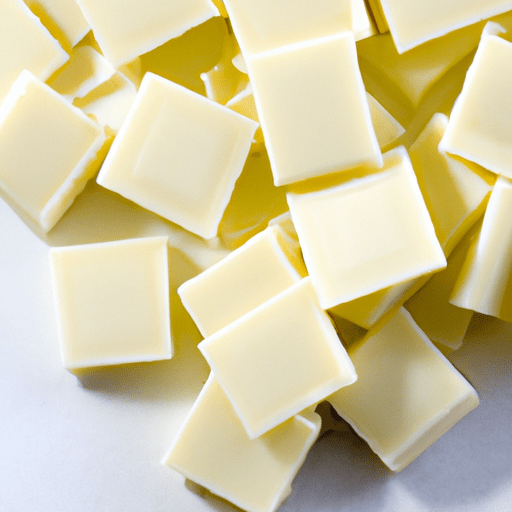Baker’s White Chocolate: A Creamy and Versatile Addition to Your Recipes
White chocolate is a delectable treat loved by many, and baker’s white chocolate takes the culinary experience to a whole new level. With its smooth and velvety texture, it adds a touch of luxury to any dish. In this blog post, we will explore the taste, common uses, nutritional value, and some interesting history and facts about baker’s white chocolate.
The Taste of Baker’s White Chocolate
Baker’s white chocolate has a rich and sweet flavor that is sure to satisfy your sweet tooth. Unlike dark or milk chocolate, it does not contain any cocoa solids. Instead, it consists primarily of cocoa butter, milk solids, sugar, and vanilla. This results in a creamy and buttery taste with subtle hints of vanilla.
Common Uses in Cooking
Baker’s white chocolate is incredibly versatile and can be used in a wide range of culinary creations. Here are just a few common uses:
Baking: White chocolate makes for a fantastic addition to cookies, cakes, brownies, and muffins. Whether melted and mixed into the batter or chopped into chunks for added texture, it can take your baked goods to the next level.
Desserts: From mousses and custards to truffles and fudge, baker’s white chocolate is a staple in many dessert recipes. Its smooth and sweet qualities complement fruity flavors such as berries and tropical fruits.
Sauces and Ganaches: Melted white chocolate can be transformed into a luscious sauce or ganache to drizzle over ice cream, pancakes, or waffles. Its rich consistency adds a touch of decadence to any dessert.
Decorations: White chocolate can be melted and piped into decorative shapes, curls, or even used for coating fruits, pretzels, or nuts. It adds an elegant touch to your dessert presentation.
Nutritional Value
While baker’s white chocolate is undeniably delicious, it is important to note its nutritional composition. Here is an overview of its approximate nutritional values per 100 grams:
- Calories: 560
- Fat: 31 grams
- Saturated Fat: 18 grams
- Carbohydrates: 59 grams
- Sugar: 55 grams
- Protein: 7 grams
While white chocolate contains calcium, vitamins, and minerals found naturally in cocoa butter and milk solids, it is high in calories and saturated fat. Moderation is key when enjoying this delightful treat.
History and Fun Facts
- White chocolate was first introduced by Nestlé in Switzerland in the 1930s.
- Unlike other types of chocolate, white chocolate does not contain cocoa solids, which are responsible for the distinct flavors found in dark and milk chocolate.
- The FDA has set specific standards for what can be labeled as white chocolate. It must contain at least 20% cocoa butter, 14% milk solids, and no more than 55% sugar.
- In some countries, white chocolate is referred to as “ivory” chocolate due to its pale color.
Now that you have a better understanding of baker’s white chocolate, it’s time to unleash your creativity in the kitchen. Whether you’re a seasoned baker or a culinary novice, this versatile ingredient is sure to inspire you to create a range of delightful desserts. So, next time you’re in the mood for something sweet and creamy, don’t forget to reach for baker’s white chocolate and indulge in its tantalizing taste!
Origin: Baker’s white chocolate does not have a specific origin as it is a variation of chocolate, which originates from the cacao tree (Theobroma cacao) that is native to Central and South America.
Common Uses: Baker’s white chocolate is commonly used in a variety of culinary applications. It is often used as an ingredient in desserts such as cookies, cakes, and pastries, where its rich and creamy texture complements the flavors of other ingredients. It is also used in confectionery and for making white chocolate ganache, truffles, and fudge.
Nutritional Benefits: Baker’s white chocolate is a good source of calories, fat, and sugar. However, it is low in dietary fiber and does not contain significant amounts of vitamins or minerals. It provides some calcium due to the milk solids present in its composition. As with any indulgent treat, moderation is key when consuming white chocolate.
Unique Properties and Historical Significance: Unlike other types of chocolate, baker’s white chocolate lacks cocoa solids, which gives it its characteristic color and flavor. It primarily consists of cocoa butter, sugar, and milk solids. White chocolate has faced some controversy regarding its categorization as chocolate, as it lacks cocoa solids, which are considered an essential component of chocolate. However, it is recognized as a distinct type of chocolate by many culinary experts and organizations.
Historically, white chocolate gained popularity in the United States during the mid-20th century, becoming widely available for home baking and confectionery use. Today, it continues to be used in various culinary creations and is appreciated for its smooth and creamy taste.




Use the share button below if you liked it.
It makes me smile, when I see it.